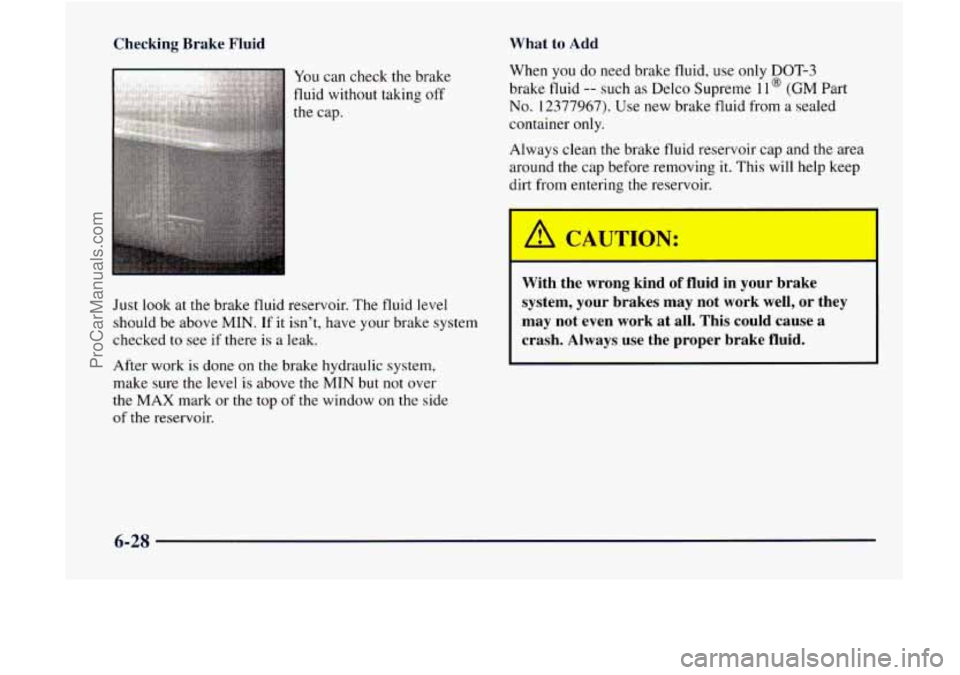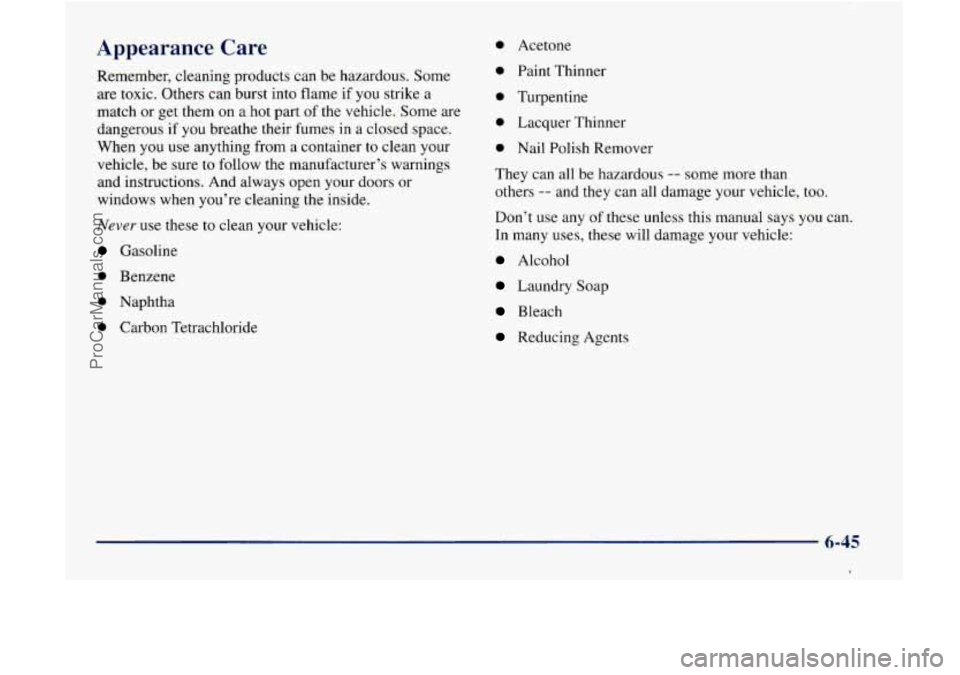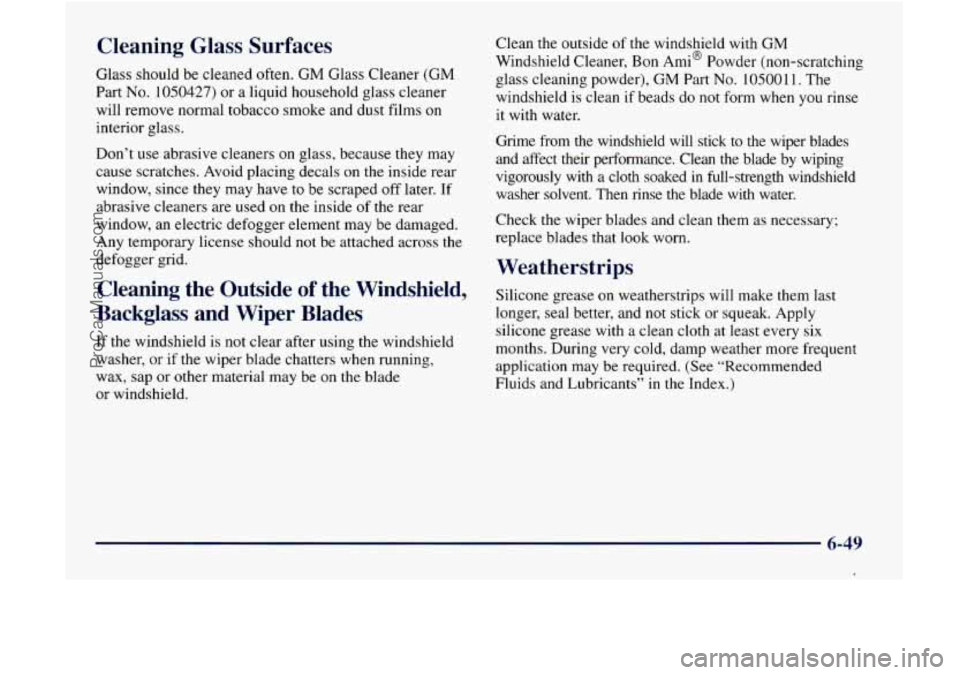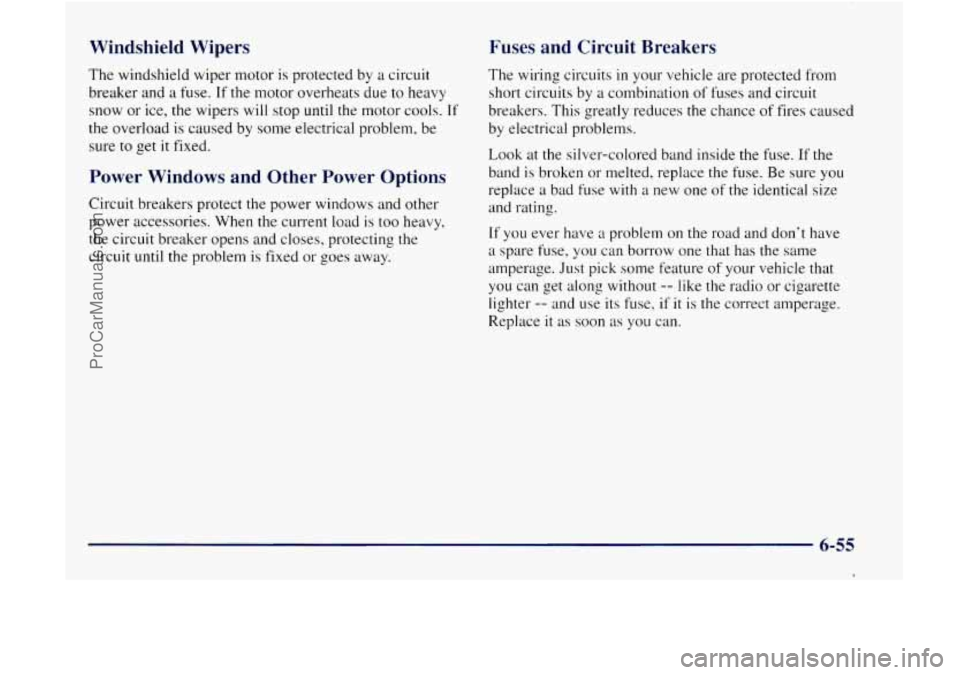1998 GMC ENVOY window
[x] Cancel search: windowPage 198 of 386

Snow can trap exhaust gases under your vehicle.
This can cause
deadly CO (carbon monoxide) gas
to get inside. CO could overcome
you and kill
you. You can’t see it
or smell it, so you might not
know it
is in your vehicle. Clear away snow from
around the base
of your vehicle, especially any
that is blocking your exhaust pipe. And check
around again from time to time to be sure snow
doesn’t collect there.
Open a window just
a little on the side of the
vehicle that’s away from the wind. This will help
keep
CO out.
Run your engine only as long as you must. This saves
fuel. When you
run the engine. make it go a little faster
than just idle. That is. push the accelerator slightly. This
uses less fuel for the heat that you get and
it keeps the
battery charged.
YOLI will need a well-charged battery to
restart the vehicle, and possibly for signaling later
on
with your headlamps. Let the heater run for a while.
Then, shut the engine off and close the window almost
all the way to preserve the heat. Start the engine again
and repeat this only when you feel really uncomfortable
from the cold.
But do it as little as possible. Preserve the
fuel
as long as you can. To help keep warm, you can get
out of the vehicle and do some fairly vigorous exercises
every half hour or
so until help comes.
Recreational Vehicle Towing
Vehicles with the electronic shift transfer case require
special modifications before they can be towed
in this
manner. Please contact your dealer
.for the towing
information that is appropriate
for yoc~r
particular vehicle.
4-39
ProCarManuals.com
Page 207 of 386

Driving with a Trailer
A CAUTION: I
0
0
0
If you have a rear-most window open and you
pull a trailer with your vehicle, carbon monoxide
(CO) could come into your vehicle. You can’t see
or smell
CO. It can cause unconsciousness or
death. (See ‘(Engine Exhaust” in the Index.) To
maximize your safety when towing a trailer:
Have your exhaust system inspected for
leaks, and make necessary repairs before
starting on your trip.
Keep the rear-most windows closed.
If exhaust does come into your vehicle
through a window in the rear or another
opening, drive with your front, main
heating or cooling system on and with the
fan on any speed. This will bring fresh,
outside air into your vehicle.
Do not use
RECIRCULATION because it only
recirculates the air inside your vehicle. (See
“Comfort Controls” in the Index.)
Towing a trailer requires a certain amount of experience, ~
Before setting out for the open road, you’ll want to get
to know your rig. Acquaint yourself with the feel of
handling and braking with the added weight of the
trailer. And always keep in mind that the vehicle you
arc
driving is now a good deal longer and not nearly as
responsive as your vehicle is by itself.
Before you
start, check the trailer hitch and platform
(and attachments), safety chains, electrical connector,
lamps, tires and mirror adjustment. If the trailer has
electric brakes, start your vehicle and trailer moving and
then apply the trailer brake controller by hand to be sure
the brakes are working. This lets you check your
electrical connection at the same time.
During your trip, check occasionally to
be sure that the
load is secure, and that the lamps and any trailer brakes
are still working.
Following Distance
Stay at least twice as far behind the vehicle ahead as you 1
would when driving your vehicle without a trailer. This
can help you avoid situations that require heavy braking
and sudden turns.
4-48
ProCarManuals.com
Page 223 of 386

io Stea 5 Coming From Your Engine
~i you get the overheat warning but see or hear no
steam, the problem may not be too serious. Sometimes
the engine can get
a little too hot when you:
0 Climb a long hill on a hot day.
Stop after high-speed driving.
Idle for long periods in traffic.
Tow a trailer. See “Driving on Grades” in the Index.
If you get the overheat.warning with no sign of steam,
try this for a minute or
so:
1. Turn off your air conditioner.
2. Turn on your heater to full hot at the highest fan
speed and open the window
as necessary.
3. If you’re in a traffic jam, shift to NEUTRAL (N);
otherwise, shift to the highest gear while
driving
-- DRIVE (D) or THIRD (3).
If you no longer have the overheat warning, you can
drive. Just to be safe, drive slower for about
10 minutes.
If the warning doesn’t come back on, you can
drive normally.
If the warning continues, pull over, stop, and park your
vehicle right away.
If there’s still no sign of steam, push the accelerator until
the engine speed is about twice as fast as normal idle
speed. Bring the engine speed back to normal idle speed
after two or three minutes.
Now see if the warning stops.
But then, if you still have the warning, turn ojfthe
engine nnd
get everyone out of the vehicle until it
cools down.
You may decide not to lift the hood but to get service
help right away.
5-12
ProCarManuals.com
Page 275 of 386

Checking Brake Fluid What to Add
You can check the brake
fluid without taking off
the cap.
Just look at the brake fluid reservoir. The fluid level
should be above
MIN. If it isn’t, have your brake system
checked to see if there is a leak.
After work is done
on the brake hydraulic system,
make sure
the level is above the MTN but not over
the
MAX mark or the top of the window on the side
of the reservoir. When
you do need brake fluid, use only
DOT-3
brake fluid -- such as Delco Supreme 11 @ (GM Part
No.
12377967). Use new brake fluid from a sealed
container only.
Always clean the brake fluid reservoir cap and the
area
around the cap before removing it. This will help keep
dirt from entering the reservoir.
A CAUTION:
With the wrong kind of fluid in your brake
system, your brakes may not work well, or they
may not even work at
all. This could cause a
crash. Always use the proper brake fluid.
6-28
ProCarManuals.com
Page 292 of 386

Appearance Care
Remember, cleaning products can be hazardous. Some
are toxic. Others can burst into flame if you strike a
match or get them
on a hot part of the vehicle. Some are
dangerous if you breathe their fumes in a closed space.
When you use anything from a container to clean your
vehicle, be sure to follow the manufacturer’s warnings
and instructions. And always open your doors or
windows when you’re cleaning the inside.
Never use these to clean your VI cle:
Gasoline
..
0 Benzene
0 Naphtha
0 Carbon Tetrachloride
0 Acetone
0 Paint Thinner
0 Turpentine
0 Lacquer Thinner
0 Nail Polish Remover
They can all be hazardous
-- some more than
others
-- and they can all damage your vehicle, too.
Don’t use any of these unless this manual says you can.
In many uses, these will damage your vehicle:
Alcohol
Laundry Soap
Bleach
Reducing Agents
ProCarManuals.com
Page 296 of 386

Cleaning Glass Surfaces
Glass should be cleaned often. GM Glass Cleaner (GM
Part No. 1050427) or a liquid household glass cleaner
will remove normal tobacco smoke and dust films on
interior glass.
Don’t use abrasive cleaners on glass, because they may
cause scratches. Avoid placing decals on the inside rear
window, since they may have to be scraped off later.
If
abrasive cleaners are used on the inside of the rear
window, an electric defogger element may be damaged.
Any temporary license should not be attached across the
defogger grid.
Cleaning the Outside of the Windshield,
Backglass and Wiper Blades
If the windshield is not clear after using the windshield
washer,
or if the wiper blade chatters when running,
wax, sap or other material may be on the blade
or windshield. Clean
the outside of the windshield with
GM
Windshield Cleaner, Bon Ami@ Powder (non-scratching
glass cleaning powder),
GM Part No. 105001 1. The
windshield is clean
if beads do not form when you rinse
it with water.
Grime from the windshield will stick to the wiper blades
and affect their performance. Clean
the blade by wiping
vigorously with a cloth soaked in full-strength windshield
washer solvent. Then rinse the blade with water.
Check the wiper blades and clean them as necessary;
replace blades that look worn.
Weatherstrips
Silicone grease on weatherstrips will make them last
longer, seal better, and not stick or squeak. Apply
silicone grease with a clean cloth at least every six
months. During very cold, damp weather more frequent
application may be required. (See “Recommended
Fluids and Lubricants” in the Index.)
6-49
ProCarManuals.com
Page 302 of 386

.dshield Wipers
I he windshield wiper motor is protected by a circuit
breaker and
a fuse. If the motor overheats due to heavy
snow or ice, the wipers will stop
until the motor cools. If
the overload is caused by some electrical problem, be
sure to get
it fixed.
Power Windows and Other Power Options
Circuit breakers protect the power windows and other
power accessories. When the current load is too heavy,
the circuit breaker opens and closes, protecting the
circuit
until the problem is fixed or goes away.
Fuses and Circuit Breakers
The wiring circuits in your vehicle are protected from
short circuits by a combination of fuses and circuit
breakers. This greatly reduces the chance
of fires caused
by electrical problems.
Look at the silver-colored band inside the fuse. If the
band
is broken or melted. replace the fuse. Be sure you
replace a bad fuse
with a new one of the identical size
and rating.
If you ever have a problem on the road and don’t have
a spare fuse, you can borrow one that has the same
amperage. Just pick some feature
of your vehicle that
you can get
along without -- like the radio or cigarette
lighter
-- and use its fuse, if it is the correct amperage.
Replace
it as soon as you can.
6-55
I
ProCarManuals.com
Page 304 of 386

FuseKircuit Usage
Breaker
2
3
4
8
9
10
11
12 Cigarette
Lighter, Data
Link Connector
Cruise Control Module and
Switch, Body Control Module,
Heated Seats
Gages, Body Control Module,
Instrument Panel Cluster
Interior Lights
Not Used
Power Outside Mirror, Power
Lock Relay
Courtesy Lamps, Battery
Run-Down Protection
Not Used
Turn Signal
Cluster, Engine Control Module
Parking Lamps, Power Window
Switch, Body Control Module,
Ashtray Lamp
FuseKircuit
Breaker
13
14
15
16
17
18
19
20
21
22
23
24
Usage
Auxiliary Power
Power Locks Motor
4WD Switch, Engine Controls (VCM, PCM, Transmission)
Air Bag
Front Wiper
Not Used
Radio Battery
Amplifier
HVAC
I (Automatic), HVAC
Sensors (Automatic)
Anti-Lock Brakes
Rear Wiper
Radio, Ignition
6-57
ProCarManuals.com